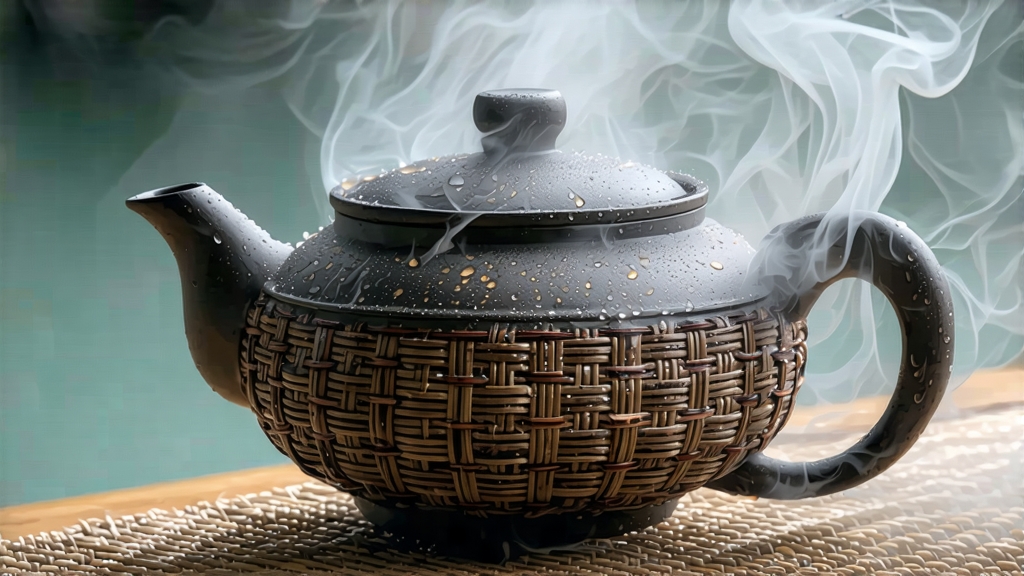
Tucked into the southern folds of China’s Guangxi Zhuang Autonomous Region, Liupu tea sleeps in mountain caves the way Burgundy sleeps in limestone cellars. To the uninitiated it looks like a forgotten building block—compressed coal-black slabs wrapped in frayed bamboo husks—yet once unraveled it releases a fragrance that Marco Polo might have dismissed as impossible: damp forest floor after rain, stewed dark plums, and the faintest echo of camphor that makes you think of your grandmother’s cedar chest. Liupu is the quietest celebrity of China’s dark-tea family, historically shipped down the Xunjiang and Pearl Rivers on bamboo rafts to Guangzhou’s “Tea Street” and then on to Southeast Asia, where dock workers brewed it in tin pots to cut the grease of roast duck and the humidity of the tropics. Today the same leaf is courted by collectors who speak of vintages the way oenophiles speak of 1982 Bordeaux, and by wellness seekers who trust its microbial alchemy to settle late-night dim-sum guilt.
The origin myth is refreshingly un-mythic. During the Qing-era Qianlong reign (1736–1795) a boatman from Cangwu County loaded green tea onto his flat-bottomed boat, intending to sell it upstream. A sudden storm forced him to moor for several days under the dripping cliffs of Liupu village. When the skies cleared the tea had turned a dull iron color and smelled oddly sweet. Frugal as any river trader, he dried it over a cypress-wood fire, pressed it into bamboo baskets, and sold it at the next port. Buyers returned asking for “that Liu-pu stuff,” and a new commodity was born. Whether apocryphal or not, the story captures the two forces that define the tea: water and time.
Although Liupu is officially classified as one of China’s six major dark teas, within Guangxi it splinters into micro-categories that mirror Burgundy’s crus. “Sanhe” Liupu is named after the three-river confluence where the leaf is first withered; “Tashan” comes from a single 300-year-old grove of medium-leaf Camellia sinensis var. sinensis perched on iron-rich laterite; and “Laoliu” refers to bricks pressed by the now-retired sixth-generation tea master Liu Zhenhai, each stamped with a tiny bat motif that symbolizes fortune. Purists argue that only leaf picked before the Grain-Rain festival and processed within a 27-kilometer radius of Liupu township deserves the name, much like Champagne’s legal cordon. Climate plays co-author: the subtropical monsoon delivers 1,600 mm of rain annually, while morning mist from the Xunjiang River slows photosynthesis, thickening cell walls and concentrating the polyphenols that will later morph into theaflavins and theabrownins.
Processing begins like green tea but ends like underground microbiology. Fresh leaves are spread on bamboo mats for five hours of wilting, during which river breeze lowers moisture to 68 %. A fifteen-minute 220 °C pan-fire kills green enzymes, yet the master’s wrist flick is gentler than Longjing makers, preserving a stubborn 12 % moisture that invites later fermentation. Rolling lasts exactly eight minutes—any longer and the leaf will bruise into sourness—then a 50-minute sun-dry brings water activity to 0.62, the sweet spot for microbial life. The pivotal step is “wo dui” (wet-piling): leaves are piled 70 cm high inside a cedar-lined room, sprinkled with Xunjiang River water drawn at dawn, and covered with jute sacks. For the next 25 days the pile breathes like a sleeping dragon; core temperature climbs to 58 °C before being turned every five days to oxygenate. A symphonic flora of Aspergillus niger, Blastobotrys adeninivorans, and local yeasts conducts a biochemical opera, converting catechins into gallic acid and eriodictyol, the molecules responsible for Liupu’s signature dried-longan sweetness and its blood-orange liquor hue. Finally the tea is steamed, pressed into 500 g bricks, and slid into bamboo husks harvested during the waning moon when sugar content is lowest, preventing mold. The bricks are carried to limestone caves whose ambient humidity hovers at 78 % and temperature at 20 °C year